Yearly Festivals
As a school, we celebrate several annual festivals. The yearly festivals play an important role in Waldorf education. Children gain an appreciation for the rhythm of the year and the changing of the seasons. They also give us a sense of community.
There are celebrations that we celebrate together as a school and some that we celebrate as a class.
As a school community, we celebrate traditional Waldorf festivals. We also celebrate festivals that reflect the diverse cultures within our school community and we often ask parents to join.
We strive to recognise and honour the unique and special cultural celebrations of all of the children in our school. This process is dynamic and fluid, as the cultures represented within our school differ from class to class, and from year to year.
These are the four festivals we always celebrate together:
Michaëlmas
September 29
Michael ensures strong crops and a good harvest. In the autumn he helps man by giving strength. He encourages people to recognize and fight evil and to prevent it. The legend of the angel Michael is a story of courage, where he overcomes evil by fighting a dragon. During Michaelmas, the Kindergarten classes make applesauce as they sing songs about autumn and the harvest. Freshly baked Michael bread is eaten. The higher classes focus on the strength and courage of Michael, and on the story of saint George (Joris) and the dragon.
Harvest festival
October 18
This is where we invite parents to join us for a harvest festival. This festival combines elements of all the other autumn festivals.
The four Sundays before Christmas are celebrated as Advent. Advent comes from the Latin word "adventus" which means coming; we may anticipate the coming of new light, after the mid-winter solstice. Every Monday after the four advent Sundays the classes are darkened and an extra candle from the advent wreath is lit. The children softly make music and sing advent songs. We look towards the dark time of year and some classes perform a midwinter or Christmas story.
Mid-winter/Christmas
We celebrate a Mid-Winter festival/Christmas during the last week before the Christmas holidays. All four candles burn in the advent wreath, the children attend the Christmas play, which is performed by the teachers. The teachers also perform the big Christmas play for parents and other interested parties.
Saint John
June 24
On June the 24th we celebrate the mid-summer solstice, which is connected to the birth date of Saint John the Baptist.
In preparation parents make a flower wreath from fresh flowers that the children wear during the celebration. The children dance and sing, games are played and we organize a picnic.
Other festivals that might be celebrated throughout the year in your child's class:
Halloween

Halloween is originally a Celtic celebration. In the Celtic calendar, 1 November is the first day of the new year. On 31 October – their New Year's Eve – they would reflect on the fact that the harvest had been brought in and the seeds were ready for the new year.
At this time people would go to the cemeteries to show their gratitude for the harvest, which was as they believed, partly due to the favour of the dead. They made offerings in the form of the gifts of the harvest and decorated the tombs with candles.
The name Halloween comes from All Hallows Eve or All Saints’ Eve – the evening before All Saints' Day on 1 November. All Saints' Day is a Catholic holiday commemorating all saints and martyrs. It was believed that on All Saints' Eve the dead spirits would return among the living and to scare away evil spirits, people wore masks.
The old Celtic traditions have evolved into a new form. Halloween is now a celebration where children dress up, go door-to-door and trick or treat. Houses are decorated with pumpkins and lights. This trick-or-treat tradition originated with poor Christians who used to go to houses on All Souls Day to beg. They begged for food to add more nutrition to their diet and promised to pray for the dead souls.
By going out into the darkness on Halloween and courageously looking for the somewhat shadowy side of life, one dares to look one's own fears in the eye. Dressing up can be fun and exciting. It is better to keep the element of fear outside our door! We can light a candle around these days and reflect on those who have passed away.
Día de los Muertos
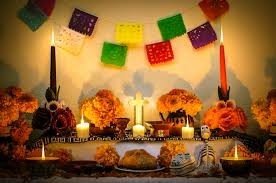
Día de los Muertos and Halloween have very different histories and contemporary evolutions. In many Latin American countries, Día de Los Muertos celebrates death in a way that signifies the perpetual cycle of life, viewing death as the beginning of a new life in another realm. In fact, many spiritual traditions believe that during this time of year (in the autumn, or in the month of October), the veil between the spirit realm and the human realm is at its thinnest. Latin cultures thus celebrate Día de los Muertos as a day to commemorate this communion.
One of the ways this is done is through the creation of an altar or ofrenda. The symbolism of the ofrenda is deeply important as it creates a central space for the living and the dead to come together. Traditionally, one might place photos, food or drink items on the altar that the deceased loved ones enjoyed in life – maybe even religious or spiritual symbols too. You might also see sugar skulls on the ofrenda which can symbolise the sweetness of life, and the overall celebratory spirit of the tradition.
Diwali
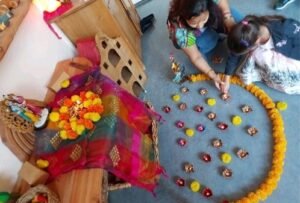
Diwali is a Hindu festival of light, held in the period from October to November. It is particularly associated with Lakshmi, the goddess of prosperity, and marks the beginning of the year in India. It comes at harvest time, and it unites three different streams of Hindu religions. Families and friends gather in homes brightly lit with oil lamps and candles. Women dress in their finest, most colourful saris and decorate their doorway floors with bright powders in intricate Rangoli designs. Sweets and cakes are freely offered, and gifts are exchanged amid joyous family reunions that culminate in firework displays.
Ramadan
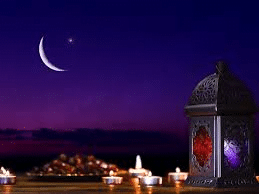
Ramadan is the ninth month in the Islamic calendar, which follows the phases of the moon. Fasting during Ramadan is one of the fundamental pillars of Islam, and Muslims who are old enough and healthy enough to fast, do so for the entire month. Adult Muslims fast from sunrise to sunset without any water or food.
Ramadan is about self-discipline and piety and is supposed to be a time of spiritual recharge. As we get through the day without food or water, it reminds us to be grateful for all our blessings. It is also a time for prayer, introspection, charity, and service. This month is about a lot more than just food!
Ramadan lanterns are the traditional lights used during the month of Ramadan to decorate houses and children are given special lanterns as a gift at the beginning of the month. The lantern is a well-known tradition during Ramadan and the concept of the lanterns originated in ancient Egypt. Shining lanterns everywhere make the month of Ramadan a beautiful time of year.
Saint Martin:
November 11
Nature withdraws. The animals hide in their holes and the trees turn yellow, red and brown. The days become shorter and the temperature drops.
According to legend, there was a soldier named Martin, who gave half of his warm cloak to a beggar. Through this act he has become the symbol of goodness and willingness to sacrifice. Goodness, sharing and giving are the central themes of this festival. The celebration of Saint Marten is 40 days before Christmas and marks the the beginning of the various light festivals that accompany us through the darker time of the year.
In Kindergarten, the children carve pumpkins and parents help, by making a lantern for their child, out of a root, like a turnip or beet, and decorate it with figures that can be seen when lit up.
The entire school is darkened during Saint Marten. The children walk through the neighbourhood with their lantern and sing songs at people’s doors.
Saint Nicholas
December 5
The trees lose their last leaves and although it is cold and bleak outside, it is warm and cosy inside.
According to legend, Saint Nicholas lived in the 4th century AD in Myra, Turkey and was a simple monk. He healed the sick and helped those in need, after which he was ordained a bishop. He died on December 6, 342. In medieval times, Nicholas became the patron saint of children and on this day, his life is celebrated by giving food and gifts.
In preparation for St Nicholas, parents help make a gift for their own. All children receive the same gift but because every parent makes it according to the taste of their own child all presents are different.
During the weeks before Saint Nicolas, Sinterklaas songs are sung and pepernoten (small spicy cookies) are baked.
Advent
from the fourth Sunday before Christmas
The darkest time of the year has arrived. Trees are bare and their leaves form a blanket. The light of the sun decreases and becomes weak, and we are inclined to seek our own inner light. The Christ Child can be seen as a symbol of such light.
Epiphany
January 6
It is winter and every day the weather gets a little bit colder. According to the story of Christmas, three wise men from the East saw a special star in the sky. For them, the star was a sign that a special child, maybe a king, was born. The three wise men followed the star to the manger where the baby lay, for they wanted to honour him. They each gave him a gift: gold, frankincense and myrrh.
At school, the children celebrate this festival within the intimacy of their class, each class in their own way.
Candlemas / (Maria Lichtmis)
February 2
The sun becomes more powerful and the days are longer. The dark period of the year is over and the light festivals end. We welcome the light of the sun, which is becoming stronger.
In class, the remaining candles are burnt and all the songs of the festivals throughout winter are sung one more time.
Chinese New Year
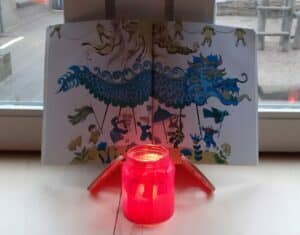
The Spring Festival (the Chinese New Year) is an annual event in China. This massive event takes place on different dates each year, but it typically begins during the beginning of February and continues until the middle of the same month (16 days in total).
Traditions include wearing red clothing and decorating houses with red items. People hang up red lanterns and cut Chinese paper cuttings to decorate their houses. Families come together and eat delicious food, and in the evening, fireworks are set off. Family elders will also often give children money in a red purse or envelope. Xinnian hao! (新年好).
Spring
The sun becomes more powerful and nature awakens. The tiny buds on the trees open up, flowers bloom and birds return and start building nests. The festivals that accompany us through this period are linked to themes of rebirth, joy, fertility and overcoming darkness: Palm Sunday, Easter, and Whitsun.
Palm Sunday
April 3
Palm Sunday is celebrated one week before Easter. In Pre-Christian times, Palm Sunday was a celebration of fertility -- it later became a Christian celebration.
The children make an Easter stick that is decorated with ribbons, eggs, currants, raisins and dried apples and on top of the stick sits a rooster made of bread. The stick symbolizes the growth and life forces of man, the eggs and the dried fruit stand for new life, and the rooster for the new day. During the celebration of Palm Easter, the home-made bread roosters are stuck on top of the sticks, and the children sing songs, while they walk with their nicely decorated Palm Easter sticks.
Easter
April 12 (the first Sunday after the first full moon in the spring)
Nature has reawakened more and more: trees and flowers start to grow and bloom. The spring equinox is on the 21st of March, where night and day last just as long. After this happens, spring has started, and Easter is celebrated on the first Sunday after the first full moon. This is when the Christians remember the resurrection of Christ.
In school we celebrate Easter as a spring festival and the renewal of life, by painting eggs and sowing seeds for the new year.
Whitsun
Fifty days after Easter, May 29 (at school)
Almost everything in nature is in bloom. Summer is on its way.
An important element in this holiday is nature bursting into bloom and birds who lay their eggs. We celebrate nature at its most beautiful.
The children dance and sing in white clothes around the Maypole.
Keti-Koti
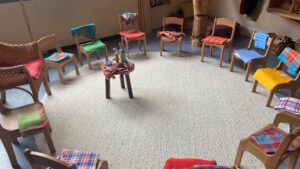
‘Keti-Koti’ means ‘broken chains’ in the Creole language Sranangtongo, spoken in Surinam. This festival that takes place on 1 July is about celebrating freedom, as it marks the abolition of slavery by The Netherlands in Surinam (Dutch Guyana) and the Dutch Antilles in 1863. It wasn’t until a decade later however, that the slaves were actually freed from their work on the plantations. As of today, campaigners are calling for a public holiday in The Netherlands to commemorate the end of slavery on this day.
About IWSTH
The International Waldorf School of The Hague is a non-profit international primary school with a distinct educational vision. Engagement with societal developments in sustainability, peace, justice and well-being plays a key role in shaping our educational programme.
